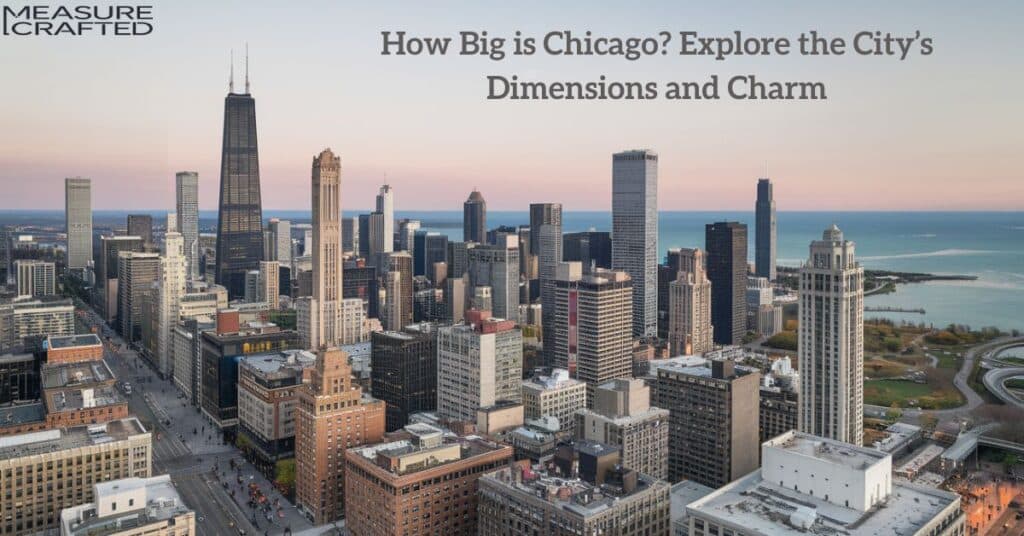Chicago, known as the “Windy City,” is one of the most unique cities in the world. With a combination of stunning urban architecture, rich history, and cultural diversity, Chicago draws in visitors and residents alike.
But just how big is Chicago? This article dives into the city’s size, geography, neighborhoods, landmarks, and more, giving you a complete picture of what makes it a captivating place to explore.
Excited about, 11 Things That Are 80 Feet (ft) Long
Geographic Overview of Chicago
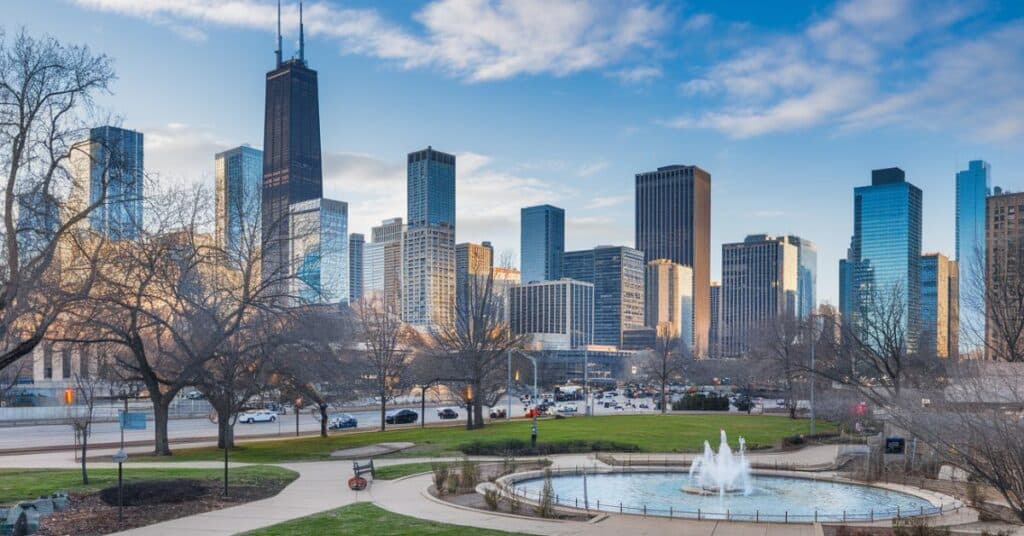
Below are the key aspects of Chicago’s geographic setting and climate that define its unique character and influence its growth.
Location and Setting
Chicago sits on the southwestern shore of Lake Michigan, part of the Great Lakes region, which is the largest group of freshwater lakes on Earth by area. The city’s coordinates place it at approximately 41.8781° N, 87.6298° W in the Midwest region of the United States.
This location contributes to Chicago’s unique climate and makes the city a central hub for commerce and travel in the US.
Climate and Weather Patterns
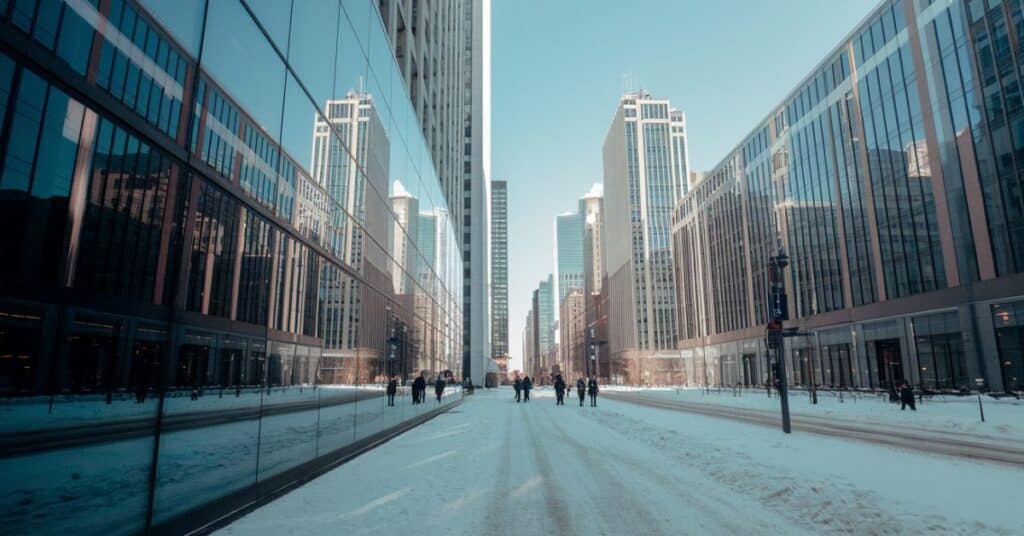
Chicago’s climate is classified as humid continental, which is characterized by hot, humid summers and cold, snowy winters. The city’s weather is heavily influenced by its proximity to Lake Michigan, especially in the winter months.
The lake effect causes significant snowfall in certain areas, particularly along the lakefront, creating a stark contrast to the dry winter conditions found further inland.
Chicago’s seasonal changes offer a glimpse into the city’s dynamic climate and contribute to the diverse experiences residents and visitors enjoy:
- Winter (December–February): Cold temperatures average lows of 18°F with heavy snowfall, especially near the lake.
- Summer (June–August): The city warms up to an average high of 85°F, accompanied by high humidity and occasional thunderstorms.
- Spring/Fall: These transitional seasons bring milder temperatures and unpredictable weather, with sudden shifts between warmth and chilly breezes.
City Limits and Area of chicago
Below is a detailed breakdown of Chicago’s dimensions, land distribution, and its surrounding metropolitan area.
Exact Dimensions and Boundaries
Chicago spans an area of 234 square miles (606 km²), making it the third largest city in the U.S. by land area. Of this total, approximately 227 square miles are land, while the remaining 7 square miles are covered by water, primarily due to its location along the shore of Lake Michigan.
| Measurement | Value |
|---|---|
| Total Area | 234 sq miles |
| Land Area | 227 sq miles |
| Water Area | 7 sq miles |
Neighboring Cities and Suburbs
Chicago is at the heart of the sprawling Chicagoland area, which includes a network of suburbs such as Evanston, Naperville, and Oak Park. This metropolitan region extends across parts of Illinois, Indiana, and Wisconsin, with a population of about 9.5 million people, making it one of the largest urban agglomerations in the U.S.
Natural and Man Made Geography

Below are some of the key natural and man made features that contribute to the city’s unique geography and charm.
Lake Michigan and Waterfront
Lake Michigan plays a significant role in shaping Chicago’s geography, contributing to its 26 mile stretch of public beaches, scenic waterfront trails, and lush parks.
The lakefront defines Chicago’s eastern edge, offering a striking contrast between the urban skyline and the natural expanse of water, highlighting the city’s unique blend of nature and urbanization.
Chicago River
The Chicago River is another defining geographic feature, flowing through the city’s center and connecting with the Great Lakes. Notably, the river was engineered to reverse its flow in the 19th century to improve sanitation, marking one of Chicago’s early feats of urban innovation.
Get more insights, 13 Things That Are About 25 Feet Long/Big
Parks and Green Spaces
Chicago’s urban landscape is enriched by over 8,800 acres of parkland, with parks like Grant Park and Millennium Park serving as central recreational hubs. These green spaces offer a balance between the city’s sprawling urban area and its natural beauty, attracting millions of visitors and enhancing the city’s charm.
Neighborhoods and Community Structure
Below are some key aspects that showcase the diversity and cultural richness of Chicago’s neighborhoods and community areas.
The 77 Community Areas
It is divided into 77 official community areas. Each area has a distinct personality and culture, representing the diversity and vibrancy of the city. Notable community areas include:
- Lincoln Park: Famous for its zoo and beautiful historic architecture.
- Hyde Park: Home to the University of Chicago and the Museum of Science and Industry.
- Bronzeville: A center of African American culture and history.
Ethnic Enclaves and Cultural Diversity
Chicago’s neighborhoods reflect the city’s rich cultural heritage. Chinatown, Greektown, Little Italy, and Pilsen are neighborhoods that offer authentic cuisine, cultural festivals, and historical insights into Chicago’s immigrant communities.
Chicago vs. Major Global Cities
To better understand Chicago’s size and character, here’s a comparison of its dimensions and layout with other major cities, both within the U.S. and globally.
Comparison to Major US Cities
When comparing Chicago to other major US cities, its size stands out. Chicago is the third largest city by population in the U.S., after New York City and Los Angeles. However, it is less dense than New York City, with its urban sprawl providing more open spaces in neighborhoods.
This isn’t just about reading stories; it’s about experiencing them. You might wonder why Hello Magazine has become a household name and what it offers that keeps readers like you coming back for more. The answer lies in its unique blend of glamour, authenticity, and the irresistible human stories that draw you in.
Here is a quick comparison of Chicago with other large U.S. cities:
| City | Population | Area (sq miles) | Density (people/sq mile) |
|---|---|---|---|
| Chicago | 2.7 million | 234 | 11,900 |
| New York City | 8.5 million | 302.6 | 27,000 |
| Los Angeles | 3.9 million | 503 | 7,500 |
Global Comparisons
Globally, it is often compared to other major metropolitan areas like London, Paris, San Francisco, and Beijing. Here are a few key points about Chicago’s size in relation to other cities:
- London: At 607 square miles, it’s slightly larger than Chicago by area, but its population is roughly 9 million, making it denser than Chicago.
- Paris: With an area of 40 square miles, Paris is much smaller than Chicago, yet its cultural influence and importance as a global city rival Chicago’s.
- Beijing: Known for its sprawling suburbs, Beijing covers a larger area than Chicago, approximately 6,300 square miles, but its population exceeds 21 million.
Navigating Chicago

Below is an overview of how to navigate Chicago’s vast urban landscape, from its unique grid layout to its public transit options.
Getting Across the City
Chicago’s expansive size and grid based layout make it easy to navigate, with streets organized in a systematic, numbered pattern. However, despite the straightforward layout, travel times can fluctuate due to traffic, especially during the busy rush hours.
Travel Times
- Loop to Lincoln Park: About 20-30 minutes by car or 20 minutes by public transit.
- Loop to Hyde Park: Takes about 30-40 minutes by car or 35 minutes via the Red Line train.
- O’Hare Airport to Downtown: Around 30-45 minutes by car or 45 minutes via the Blue Line train.
Want to explore furthur, 12 Everyday Things That Are 2 Centimeters Long
Public Transit and Accessibility
The Chicago Transit Authority (CTA) operates the famous “L” trains, buses, and Metra commuter trains. The “L” trains are particularly popular for commuting and sightseeing, offering convenient access to most of the city’s neighborhoods and landmarks.
Accommodation Options in Chicago
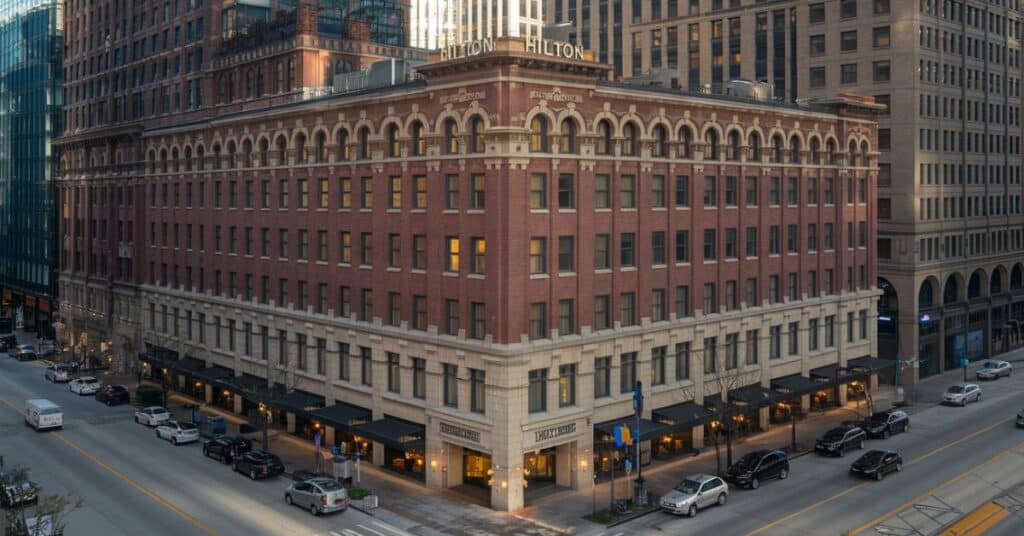
As one of the largest and most vibrant cities in the U.S., Chicago offers a wide range of accommodations, from historic landmarks to luxury stays:
- Palmer House Hilton: One of the oldest hotels in the city, located in the heart of the Loop, showcasing Chicago’s rich history and architectural beauty.
- The Drake: A historic hotel near the Magnificent Mile, combining timeless elegance with convenient access to shopping and cultural attractions.
- Ritz Carlton Chicago: A luxurious hotel offering stunning views of Lake Michigan and unparalleled service, reflecting the city’s upscale hospitality.
Higher Education and Academic Influence
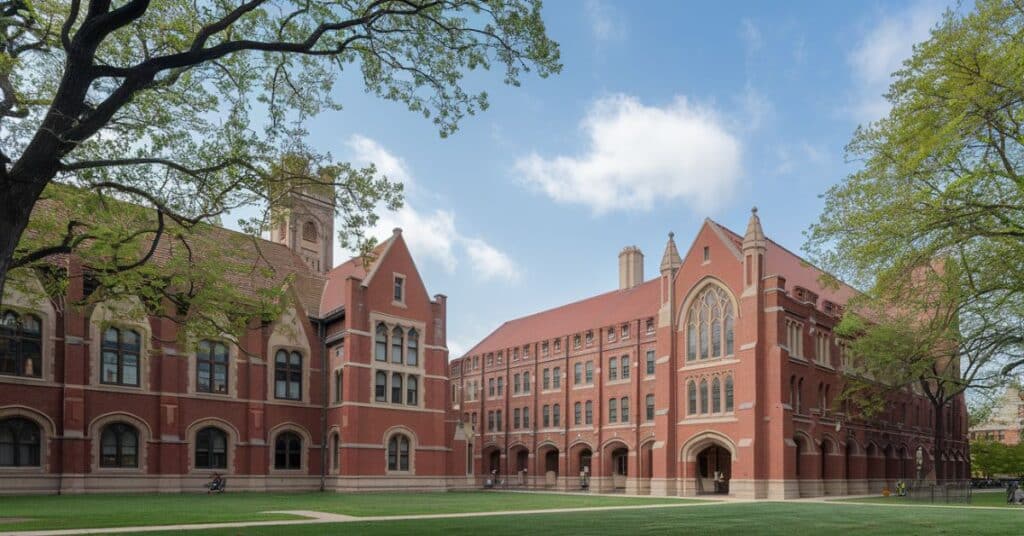
Explore how Chicago’s prestigious universities contribute to the city’s rich academic, cultural, and economic tapestry, highlighting their global impact.
Top Universities and Their Campuses
Chicago’s stature as a major cultural and economic hub is reinforced by its world class academic institutions, which add to the city’s intellectual and cultural dimensions:
- University of Chicago: Renowned for its Nobel winning research and historic campus. It also plays a vital role in shaping the city’s economy through its groundbreaking research and partnerships with local industries.
- Northwestern University: Offers prestigious programs in law, journalism, and medicine, contributing to the city’s academic reputation. Its campuses extend into Evanston, bringing a blend of urban and suburban influence to the greater Chicago area.
- DePaul University: Known for its strong business and liberal arts programs, adding to Chicago’s diverse academic landscape. The university’s downtown campus also positions it at the heart of the city’s business and cultural activity.
These universities play a significant role in Chicago’s intellectual and cultural life, driving innovation and education.
Healthcare Systems and Facilities
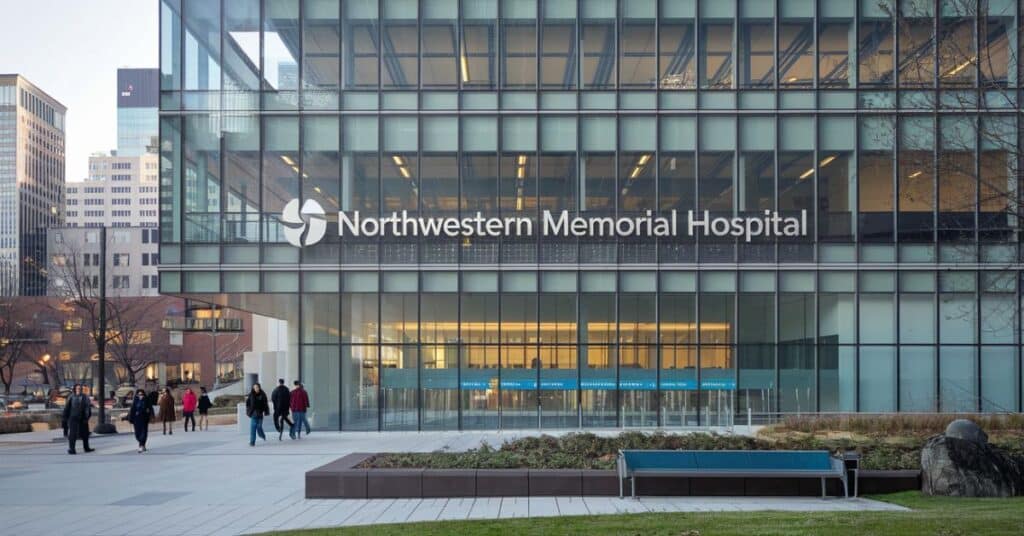
Below are the following healthcare institutions that solidify Chicago’s reputation as a leader in medical innovation and care:
Leading Hospitals in Chicago
Chicago’s healthcare system ranks among the best in the United States, reflecting the city’s significant scale and global influence. Leading hospitals include:
- Northwestern Memorial Hospital: Known for cutting edge research and comprehensive care. It consistently ranks among the top hospitals nationwide for specialties like cardiology and oncology.
- University of Chicago Medical Center: A leader in innovative treatments and medical education. Its Hyde Park location combines a state of the art facility with a commitment to serving diverse communities.
- Rush University Medical Center: Renowned for specialized services and community health initiatives. The hospital is a pioneer in telemedicine and has played a critical role in public health responses.
These world class facilities not only cater to local residents but also draw patients from across the country, underscoring Chicago’s reputation as a healthcare hub.
A Historical Perspective on Chicago’s Growth
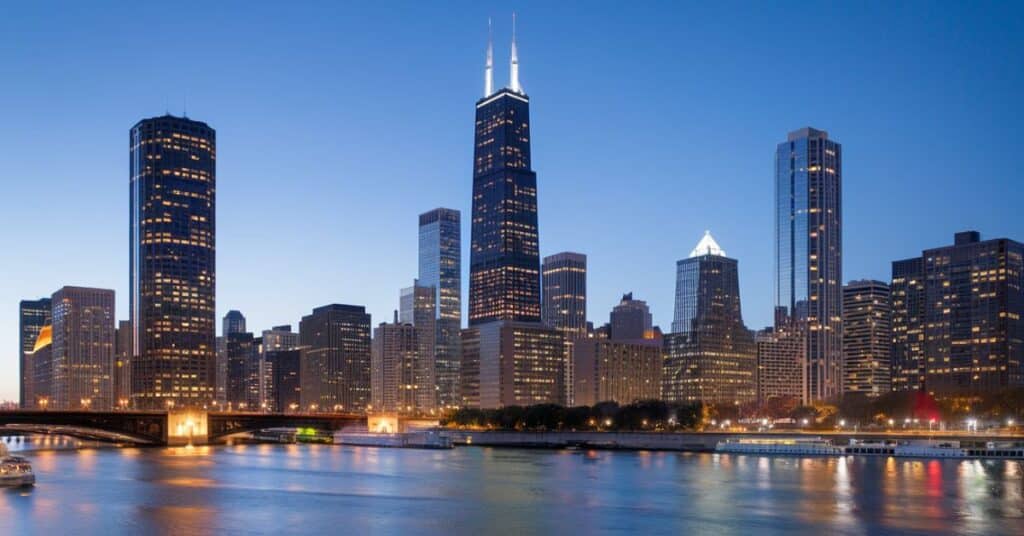
Below is a brief overview of Chicago’s remarkable journey from its humble beginnings to its modern architectural brilliance:
Early Settlement and Development
Chicago’s origins trace back to a modest trading post in the late 18th century, strategically located by Lake Michigan and the Chicago River.
Its position at the crossroads of waterways and railroads fueled rapid growth in the 19th century. This strategic location transformed Chicago into a critical hub for commerce and transportation as America expanded westward.
The Great Chicago Fire
The Great Chicago Fire of 1871 devastated much of the city, but it marked a turning point in its history. The rebuilding process ushered in a new era of innovation, culminating in the rise of Chicago’s famous skyscrapers and advanced urban planning, which set the stage for its modern skyline.
Modern Growth and Transformation
The 20th century heralded a period of modernization and architectural milestones. Chicago’s construction of the Home Insurance Building, the world’s first skyscraper, revolutionized urban landscapes globally.
Today, the city continues to evolve, blending historic charm with cutting edge design and infrastructure.
Population and Demographics
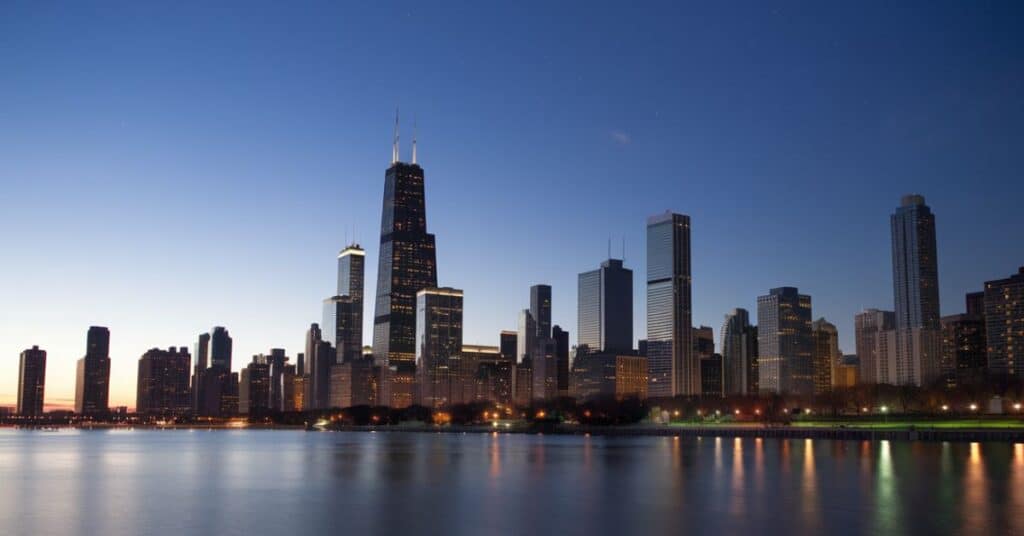
Below are insights into Chicago’s population and the rich cultural diversity that defines its unique identity.
Population Overview and Density
With a population of approximately 2.7 million, Chicago stands as the third largest city in the United States. Spanning its 234 square miles, the city boasts a population density of about 11,900 people per square mile, reflecting its dynamic mix of bustling urban areas and open spaces.
Interested about, What Are The Dimensions of a Pringles Can?
Diverse Cultural Fabric
Chicago’s population is a vivid tapestry of cultures, shaped by large communities of Irish, Italian, Polish, African American, Latino, and Asian residents. This diversity enriches the city’s neighborhoods, festivals, and culinary offerings, making Chicago a true cultural mosaic.
Chicago Economy

Chicago boasts a diverse and robust economy, making it one of the most significant economic hubs in the United States. Key industries driving the city’s growth include:
- Finance and Banking: The city is a global leader and home to major institutions like the Chicago Board of Trade and the Chicago Mercantile Exchange.
- Manufacturing: Known historically as the “Workshop of the World,” Chicago continues to thrive in industries like machinery, food production, and electronics.
- Transportation and Logistics: As a central transportation hub, Chicago facilitates global trade through its airports, railways, and waterways.
- Healthcare and Technology: The city is advancing rapidly in tech innovation, biotech, and healthcare, contributing to its reputation as a center for cutting edge industries.
Notable Neighborhoods in chicago
Chicago is renowned for its vibrant and diverse neighborhoods, each contributing to the city’s dynamic character and charm:
- The Loop: Chicago’s bustling central business district, packed with theaters, iconic shops, skyscrapers, and historical landmarks like the Art Institute of Chicago. This neighborhood epitomizes the city’s economic and cultural heartbeat.
- Wicker Park: This trendy area is famous for its eclectic mix of boutiques, art galleries, and a thriving nightlife scene, showcasing the city’s contemporary edge.
- Gold Coast: One of Chicago’s most prestigious neighborhoods, featuring upscale shopping on Oak Street, luxury residences, and picturesque views along the Lake Michigan shoreline.
Arts Scene and Cultural Events in chicago
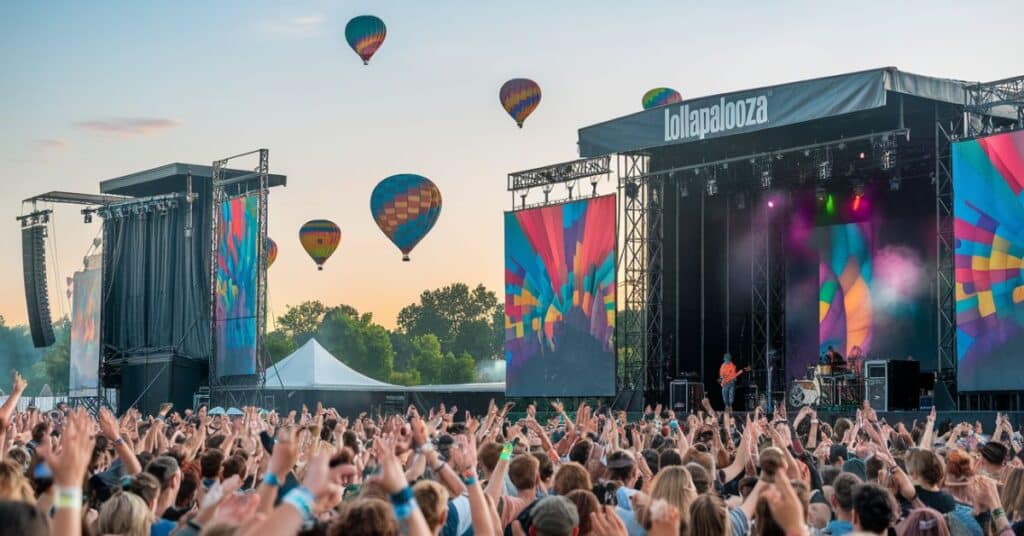
Chicago’s immense size is matched by its rich and diverse arts and cultural offerings, which cater to a wide array of tastes and interests:
- Art Institute of Chicago: Famous for its vast collection spanning centuries, including iconic works like American Gothic and Nighthawks. The museum’s grandeur reflects Chicago’s standing as a global cultural hub.
- Chicago Symphony Orchestra: One of the world’s leading orchestras, delivering performances that attract audiences from across the globe, enhancing the city’s reputation.
- Annual Festivals: Events like Lollapalooza and Taste of Chicago draw millions of visitors. It transforms the city into a vibrant celebration of music, food, and culture.
Tourism, Shopping and Entertainment in chicago
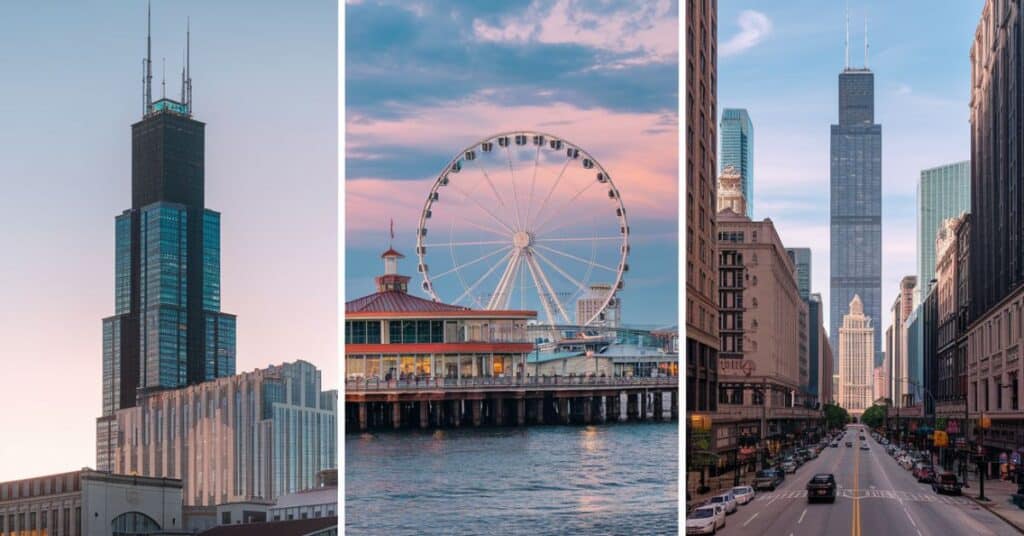
Chicago’s scale and vibrancy come alive through its iconic landmarks, premier shopping districts, and culinary delights.
Read more, 9 Things That Are 500 Feet Long or Big
Famous Landmarks and Sights
- Willis Tower: Formerly the Sears Tower, this towering skyscraper offers unparalleled views of the city, showcasing Chicago’s sprawling skyline.
- Navy Pier: A lively entertainment hub with attractions, restaurants, and a stunning waterfront, reflecting Chicago’s connection to Lake Michigan.
- Magnificent Mile: This stretch features luxury brands, flagship stores, and upscale dining, solidifying Chicago’s status as a retail hub.
Iconic Chicago Food
- Deep Dish Pizza: A world famous dish synonymous with Chicago’s culinary identity.
- Chicago Style Hot Dog: A vibrant local favorite topped with unique, colorful ingredients.
- Italian Beef Sandwiches: A delicious staple that reflects the city’s rich food heritage and love for hearty meals.
Conclusion
Chicago is a city that blends iconic architecture, rich culture, and scenic beauty. Its diverse neighborhoods offer something unique. From historic landmarks to modern skyscrapers, Chicago is a place full of contrasts.
Whether you explore its cultural scene or enjoy local cuisine, there’s always something to discover. The Windy City continues to captivate residents and visitors alike. Come experience the charm of Chicago, a city like no other.
FAQs about chicago
1. What are some lesser known attractions in Chicago?
Hidden gems like the Chicago Botanic Garden, the Magic Parlour show, and the International Museum of Surgical Science offer unique experiences.
2. Can I see the Chicago skyline from multiple locations?
Yes, you can view Chicago’s iconic skyline from various spots, including Navy Pier, Grant Park, and the John Hancock Observatory.
3. Are there any famous Chicago sports teams to watch?
Chicago is home to renowned sports teams, including the Chicago Cubs (MLB), Chicago Bulls (NBA), and Chicago Bears (NFL).
Chicago Quiz
1. What is the nickname of Chicago?
a) The Big Apple
b) The Windy City
c) The Golden Gate City
2. Which famous Chicago landmark is known for its glass floored skydeck?
a) Willis Tower
b) Navy Pier
c) Millennium Park
3. Which body of water borders Chicago to the east?
a) Lake Michigan
b) Mississippi River
c) Lake Erie
4. What famous museum in Chicago is known for its collection of Impressionist art?
a) Art Institute of Chicago
b) Museum of Science and Industry
c) Field Museum
5. Which Chicago sports team plays at Soldier Field?
a) Chicago Bulls
b) Chicago Cubs
c) Chicago Bears
Answers:
- b) The Windy City
- a) Willis Tower
- a) Lake Michigan
- a) Art Institute of Chicago
- c) Chicago Bears
Dive deeper into the topic, 15 Common Things That Are 5 Feet Long

